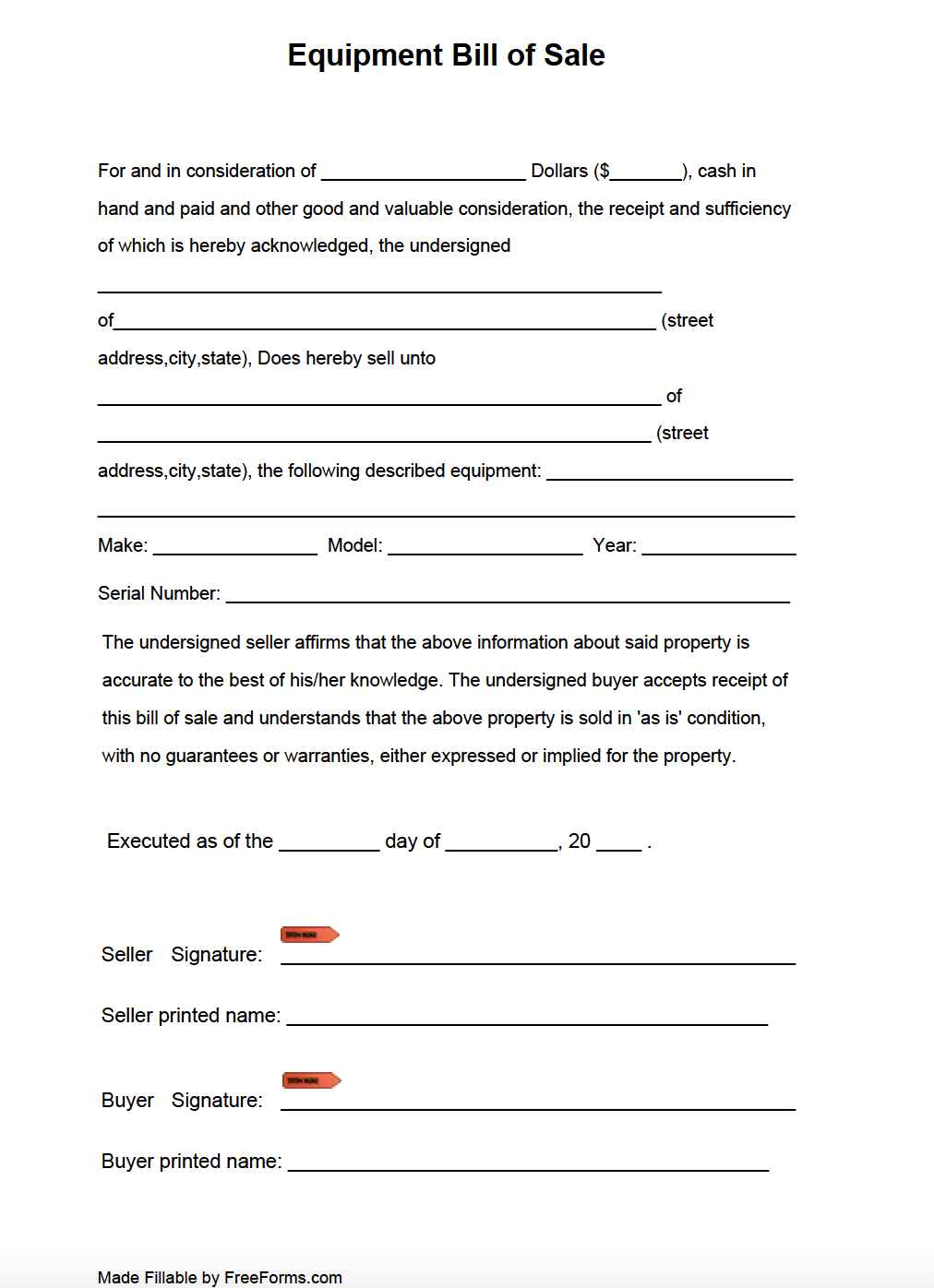An Equipment bill of sale form illustrates the details of the transfer involving a piece of equipment in a material testament for agreed upon sum of money. The contract stipulates the purchase price and identifies all participating parties involved in the transaction and produces accurate information regarding the equipment and sale terms. When exchanging goods and equipment with higher dollar amounts, having written documentation is a secure method of covering your bases to prove ownership and emphasize relinquished responsibility for the item sold.
Does all Equipment Require a Bill of Sale?
Although you are not necessarily obligated to produce a bill of sale when selling equipment, utilizing one to transcribe the arrangement is wise when transferring anything with more copious than usual sale amounts. When taking the extra precaution to furnish a written record of the transaction, many legal repercussions that could arise will have sufficient proof of sale terms and transfer of ownership to adequately demonstrate to a court should a dispute come up. Doing so will protect both the seller from any liability involved with the sold equipment after it changes hands as well as spelling out the agreement for both parties to inspect before signatures are endorsed, and money exchanged. There are many different types of equipment in which you could employ this particular bill of sale to ensure proper documentation:
- Home Appliances – Refrigerators, dishwashers, stoves/ovens, clothes washers/dryers, or smaller kitchen appliances.
- Outdoor Equipment – Lawn maintenance equipment, agriculture machinery, outdoor grills.
- Power Tools – Generators, air compressors, power saws, hand tools, and storage solutions.
- Business or Office Electronics – Photocopiers, printers, scanners, binders, filing cabinets, and fax machines.
- Audio/Visual Equipment – Receivers, speakers, staging equipment, DJ equipment, and musical instruments.
- Hobby Implements – Sports, camping, hiking, fishing, and diving equipment.
How to Sell Used Equipment
-
Inspect the Item
Thoroughly examine the piece of equipment for any issues that may need to be repaired or touched-up. Depending on the item, the visible condition may require slight improvements or repair. What may be acceptable for the appearance of a lawnmower or other outdoor working tools may not as presentable for a refrigerator to a potential buyer. You will want to double check that the device is in satisfactory working order and make any repairs as needed before you advertise the equipment.
-
Develop a Viable Advertisement
Compose an in-depth description of the sale item, making sure to list all identifying information such as the year it was manufactured, the manufacturer, model, and serial number. You also want to list all specs associated with the equipment, dimensions and any issues or defects it may have. Take 5-10 quality photos of the item in a well-lit environment focusing on several different angles, while taking close-up shots to highlight any various components or features. Research similar items for sale to evaluate a realistic listing price, you can check your local classifieds for comparable equipment. You can also check online for related listings on Craigslist or eBay to establish pricing competitive with your regional market. Make sure to include updated contact information in your ad so that possible buyers can inquire.
-
Where to List Your Promotional Material
Publicize your advertisement locally in print via area newspapers and regional classifieds circulars. Distribute flyers on bulletin boards where possible buyers may frequent. For example, if you are attempting to sell fishing equipment, you can post flyers at bait shops where those who attend may be interested. Promote your listing on online resources such as Craigslist or eBay. This can attract higher numbers of potential buyers from near and even slightly outside of your market area.
-
Finalize the Purchase
Once you receive an interest in the purchase of the equipment, you will want to schedule a visit to inspect the item and close the sale. If possible, arrange to meet in a safe public place that is convenient for both the buyer and yourself. If the purchase requires large amounts of money to be exchanged, insist that you meet at the buyer’s bank or credit union to make the exchange to avoid carrying large amounts of cash. Once an accord has been made you then fill out the bill of sale, endorse the document and exchange the funds for the purchased equipment.
Complete the Equipment Bill of Sale Form
Step 1 – Download the Adobe PDF and proceed to open and fill the form as instructed:
Step 2 – Purchase Price – In the first to allocated spaces of the document, insert the purchase price amount in the following formats:
- Written Dollar Amount
- Numerical Dollar Amount
Step 3 – Seller Information – Refer to the information corresponding to the individual selling the piece of equipment:
- Seller’s Full Name
- Seller’s Street Address
Step 4 – Buyer Information – Include the information applicable to the buyer of the equipment:
- Buyer’s Full Name
- Buyer’s Street Address
Step 5 – Equipment Information – Provide details relevant to the equipment being purchased:
- Specific description (item, color, identifying specifics)
- Manufacturer
- Model
- Year Manufactured
- Serial Number (if applicable)
Step 6 – Next, insert the exact date of the sale in the corresponding space in the format of:
- Day
- Month
- Year
Step 7 – Endorsements – Upon agreement to the contract, both buyer and seller can finalize the document in the appropriate blank spaces provided as follows:
- Seller Signature
- Seller Printed Name
- Buyer Signature
- Buyer Printed Name



0 comments
Comments are closed.